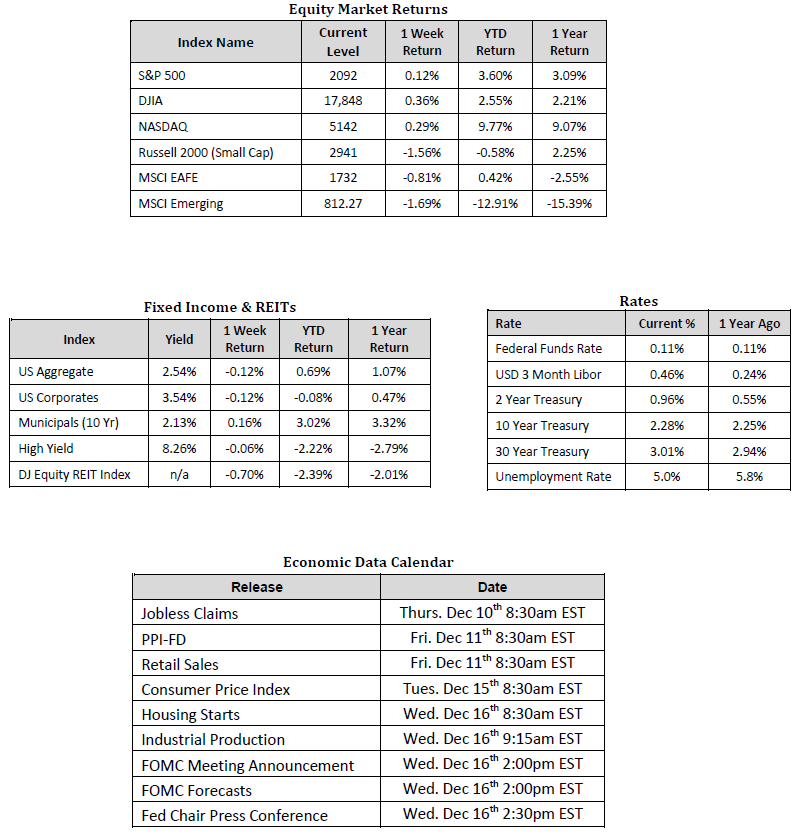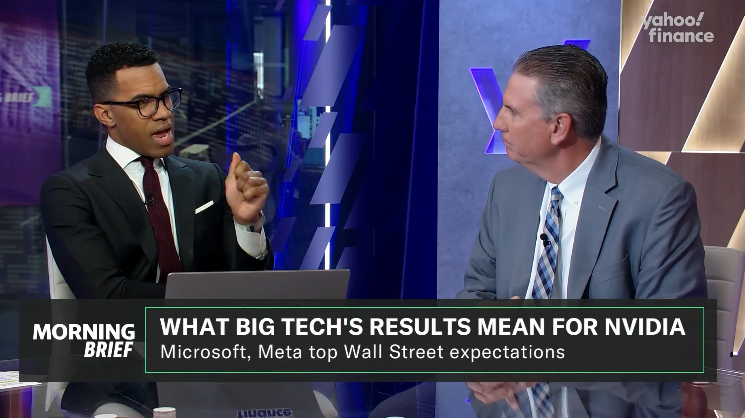
Wide Inter-Day Price Swings Heading into Year End
Market Overview

Sources: Equity Market, Fixed Income and REIT returns from JP Morgan as of 12/4/15. Rates and Economic Calendar Data from Bloomberg as of 12/7/15.
Happening Now
Stocks in the U.S. continued range bound trading last week with the S&P 500 Index posting a gain of 0.12% for the week despite wide swings on Thursday and Friday’s trading. Following Mario Draghi’s press conference Thursday morning, when he announced there would be no additional asset purchases above and beyond those previously announced, stocks in the U.S. fell sharply lower. The S&P 500 Index dropped 1.4% along with the Dow Jones Industrial Average (DJIA) which also fell 1.4% or 252 points. This was more than reversed on Friday when both the S&P 500 Index and the DJIA posted gains greater than 2% with the DJIA moving almost 400 points higher.
Bouts of inter-day volatility fueled by macro events have been a characteristic of the recovery and considering the heightened focus on the timing and pace of Fed policy, we believe they are likely to continue into 2016. In addition to wide swings in aggregate market prices, this year has seen the widest differential in style returns (growth stocks vs. value stocks) since 2009. Using the iShares Russell 1000 Growth/Value ETFs to measure the return of these two groups, we have found that growth stocks have outperformed value stocks by a margin of 8.9% so far for 2015. As noted above, this is the largest difference in returns since 2009 when growth stocks posted a 36.7% return while value stocks advanced only 19.2%, a difference of 17.5%. Considering that value stocks yield over 100 basis points more than their growth oriented counterparts, investors chasing high yields may be doing so at the expense of their total return.
Given the lofty valuations of certain sectors and asset classes along with the likelihood of increased volatility in 2016, investors would be wise to review their portfolio holdings before the end of the year. As we see each December and January, end/beginning of year trading by institutional investors can distort market prices and make it difficult for individuals to adjust their portfolio efficiently. We strongly recommend seeking the advice of a professional portfolio manager to help decide not only where to invest but also when and how to execute the necessary trades.
Important Information and Disclaimers
Disclosures: Hennion & Walsh is the sponsor of SmartTrust® Unit Investment Trusts (UITs). For more information on SmartTrust® UITs, please visit www.smarttrustuit.com. The overview above is for informational purposes and is not an offer to sell or a solicitation of an offer to buy any SmartTrust® UITs. Investors should consider the Trust’s investment objective, risks, charges and expenses carefully before investing. The prospectus contains this and other information relevant to an investment in the Trust and investors should read the prospectus carefully before they invest.
Investing in foreign securities presents certain risks not associated with domestic investments, such as currency fluctuation, political and economic instability, and different accounting standards. This may result in greater share price volatility. These risks are heightened in emerging markets.
There are special risks associated with an investment in real estate, including credit risk, interest rate fluctuations and the impact of varied economic conditions. Distributions from REIT investments are taxed at the owner’s tax bracket.
The prices of small company and mid cap stocks are generally more volatile than large company stocks. They often involve higher risks because smaller companies may lack the management expertise, financial resources, product diversification and competitive strengths to endure adverse economic conditions.
Investing in commodities is not suitable for all investors. Exposure to the commodities markets may subject an investment to greater share price volatility than an investment in traditional equity or debt securities. Investments in commodities may be affected by changes in overall market movements, commodity index volatility, changes in interest rates or factors affecting a particular industry or commodity.
Products that invest in commodities may employ more complex strategies which may expose investors to additional risks.
Investing in fixed income securities involves certain risks such as market risk if sold prior to maturity and credit risk especially if investing in high yield bonds, which have lower ratings and are subject to greater volatility. All fixed income investments may be worth less than original cost upon redemption or maturity. Bond Prices fluctuate inversely to changes in interest rates. Therefore, a general rise in interest rates can result in the decline of the value of your investment.
Definitions
MSCI- EAFE: The Morgan Stanley Capital International Europe, Australasia and Far East Index, a free float-adjusted market capitalization index that is designed to measure developed-market equity performance, excluding the United States and Canada.
MSCI-Emerging Markets: The Morgan Stanley Capital International Emerging Market Index, is a free float-adjusted market capitalization index that is designed to measure the performance of global emerging markets of about 25 emerging economies.
Russell 3000: The Russell 3000 measures the performance of the 3000 largest US companies based on total market capitalization and represents about 98% of the investible US Equity market.
ML BOFA US Corp Mstr [Merill Lynch US Corporate Master]: The Merrill Lynch Corporate Master Market Index is a statistical composite tracking the performance of the entire US corporate bond market over time.
ML Muni Master [Merill Lynch US Corporate Master]: The Merrill Lynch Municipal Bond Master Index is a broad measure of the municipal fixed income market.
Investors cannot directly purchase any index.
LIBOR, London Interbank Offered Rate, is the rate of interest at which banks offer to lend money to one another in the wholesale money markets in London.
The Dow Jones Industrial Average is an unweighted index of 30 “blue-chip” industrial U.S. stocks.
The S&P Midcap 400 Index is a capitalization-weighted index measuring the performance of the mid-range sector of the U.S. stock market, and represents approximately 7% of the total market value of U.S. equities. Companies in the Index fall between S&P 500 Index and the S&P SmallCap 600 Index in size: between $1-4 billion.
DJ Equity REIT Index represents all publicly traded real estate investment trusts in the Dow Jones U.S. stock universe classified as Equity REITs according to the S&P Dow Jones Indices REIT Industry Classification Hierarchy. These companies are REITSs that primarily own and operate income-producing real estate.



